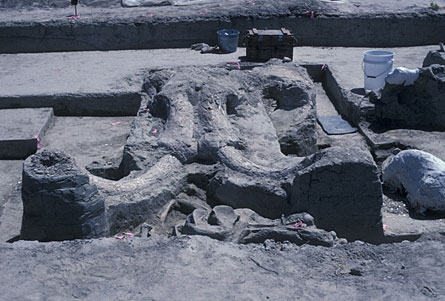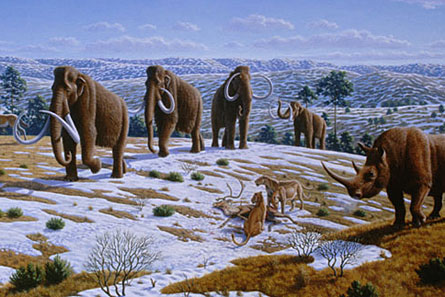Three strikes wiped out woolly mammoths
Giant mammals went extinct thanks to climate, comet and people
 |
|
Columbia mammoths, which were relatives of woolly mammoths, roamed as far south as the Black Rock Desert in Nevada, where this fossil was found. The fossil was excavated under the direction of Stephanie D. Livingston, then of the Desert Research Institute.
|
| D. Grayson |
People have been fascinated by woolly mammoths for a long time. Before people even knew how to grow crops or make things from metal, they were decorating their walls with pictures of mammoths. Scientists have found an ancient figurine of a mammoth that was carved from a mammoth tusk in Germany 35,000 years ago. And in a cave in France around the same time, someone drew a picture of a mammoth.
But over time, people stopped drawing mammoths because no more were left. The last known mammoths lived on Wrangel Island in Siberia 3,700 years ago, at the end of a time period called the Pleistocene epoch.
Scientists have long wondered why the mammoths disappeared. Cave paintings of mammoth hunts make it clear that humans killed some of the giant animals, but now scientists are learning that different groups of mammoths went extinct at different times in different places. And it took more than just people to kill them off — changes in climate and maybe even a comet from space were also to blame.
The kind of woolly mammoths that people drew was as tall as an elephant and lived in big groups. They roamed cold northern regions around the globe from about 150,000 years ago until they went extinct. They had three inches of fat beneath their skin to keep them warm. Long, shaggy hair helped keep them warm, too. The Northern Hemisphere during the age of mammoths was covered in steppe-tundra, which is a cold, dry habitat containing scattered patches of herbs, shrubs, scrubby trees and grasses, all of which the mammoths ate. Their tusks, bigger and more curved than those on elephants, probably helped them move snow to find food. When a person stood near a mammoth, could we blame them for awe? No wonder people drew mammoth pictures on cave walls.
But people were thinking about mammoths as more than models for art. Archaeologists—scientists who study ancient cultures by looking at what they leave behind—have discovered that people used mammoth bones to make tools. They used mammoth ribs to build houses. People probably ate mammoth meat and wore mammoth skins. Some people depended on mammoths for their survival.
As humans spread across Europe and Asia 40,000 years ago, they increased in number and honed their hunting abilities. During the same period (from 40,000 years ago to 3,700 years ago), mammoth populations declined and then went extinct. Beginning in 1860, scientists argued that mammoths vanished because people hunted them to extinction. Over-hunting was also blamed for the extinction of woolly rhinoceros, mastodons, cave bears and other mammals. This idea was so common that some people called it “the favorite hypothesis.”
A hypothesis is a proposal that predicts cause and effect. The “favorite hypothesis” suggested that human hunting caused mammoth extinction—but it wasn’t the only hypothesis explaining the mammoth’s demise.
In the 1800’s, scientists didn’t know what the climate was like when mammoths roamed the
Earth, but that has changed. Today, scientists look at records from deep-sea drilling and ice cores from Antarctica and Greenland. By studying the minerals and gases that were trapped in these cores long ago, they can tell what the climate was like in the past. They also look at pollen and plant fossils from all over the world to see what kinds of plants were able to live in different places in the past. Scientists now know when the mammoth’s world was cold (about 8˚C, or 46˚F, in the summer months), dry, and covered with ice sheets. They also know when it was a bit warmer (about 15˚C, or 59˚F, in the summer months) and wetter.
The steppe-tundra habitat favored by mammoths doesn’t exist today. Because woolly mammoths went extinct when ice sheets became rare and the world became warm and wet, some scientists hypothesized that changes in long-term patterns of weather, called climate change, caused mammoths to die.
Last year, a group of scientists from the Museo Nacional de Ciencias Naturales in Madrid, Spain wanted to know what killed the mammoths—and unlike scientists before them, they had data on how much steppe-tundra existed over long periods of time. They also had data on where woolly mammoth bodies had been found, and where people lived between 126,000 years ago and 6,000 years ago. Even though the human populations increased at the same time that the climate warmed and the steppe-tundra habitat vanished, the scientists were able to determine which change caused the mammoth extinction.
Twice in the history of mammoths, their steppe-tundra homes almost disappeared. The first time it happened, starting 126,000 years ago, mammoths nearly went extinct—but they recovered. The second time it happened, starting 6,000 years ago, mammoths actually went extinct. How come the mammoths died off the second time but not the first?
The first time the steppe-tundra habitats receded, humans were not fully modern. They did not have art or advanced tools. They probably couldn’t hunt something as big and intelligent as a woolly mammoth, the scientists think. Humans didn’t have the technology to survive in the very cold places woolly mammoths liked best.
By the second time steppe-tundra habitats receded , humans had changed. Through the use of more complex clothing and housing, people could survive in the cold climates favored by mammoths. Also, people had invented complicated tools, like spear-throwing devices, which allowed them to hunt more dangerous animals. We know people hunted mammoths because mammoth bones have been found with spear holes in them.
 |
|
Woolly mammoths marching across the steppe-tundra.
|
| Mauricio Anton |
The scientists from Spain suggest that climate change pushed woolly mammoths into smaller and smaller patches of steppe-tundra habitat. Humans, with their increasing numbers and new hunting technologies, finished them off.
That explanation may be satisfying, but there’s a problem, or at least a complication: mammoths weren’t the only species to go extinct during that period. At least 35 kinds of North American mammals, including camels, ground sloths, horses and mastodons, died off along with the mammoths.
Scientists have a hard time imagining that human hunters killed everything. According to Donald Grayson, an anthropologist at the University of Washington in Seattle, “One huge problem with the idea that people hunted all the late Ice Age North American mammals to extinction is that although at least 35 kinds of large mammals became extinct at this time, we can only show that humans hunted two of them—mammoths and mastodons.”
Because the over-hunting hypotheses could not be the only explanation, a group of 26 scientists from all over the world looked to the sky. Could a comet have changed North America and killed the mammals?
Richard Firestone, lead scientist and chemist from Lawrence Berkeley National Laboratory in California, describes one possible scenario: “When the comet exploded in the air over the Great Lakes, there was a loud roar, a flash of light and heat hotter than the sun. A great wind of dust and debris followed, rolling across North America to the Atlantic and Pacific Oceans. It churned up the landscape and choked the animals. Hot ash fell across the land, causing vast forest and grass fires. The sky went dark for months until the dust settled.”
Led by Firestone, the team of scientists looked for evidence of a comet. Impacts from comets often are associated with tiny diamonds called nanodiamonds. Comets can bring these diamonds to Earth, and the heat caused by impact can also change graphite in the earth into nanodiamonds. The scientists believe they found nanodiamonds caused by an impact around 12,500 years ago. Such an impact might have helped shrink the amount of steppe-tundra available for mammoths.
Like many hypotheses about extinctions, the comet hypothesis doesn’t explain everything. If a comet exploded in North America, and it was big enough to cause global climate change, then the impact crater should be visible. None is. Of course, that doesn’t mean some intrepid explorer won’t find one.
Most likely, no one thing alone wiped out all of the mammoths. Perhaps a comet destroyed some of the mammoth’s habitat, and hunters killed many of the animals that were left. A small number of mammoths held on in other areas, like on Wrangel Island, only to eventually die off later
People were thinking about woolly mammoths 30,000 years ago, and they are still thinking about them now. People will probably be thinking about woolly mammoths for years to come. The icy, dry world filled with hairy giants has melted away, but it lives on in laboratories—and our imaginations.







